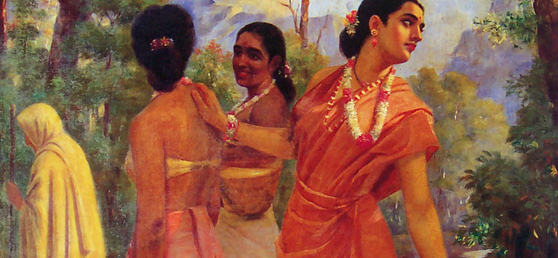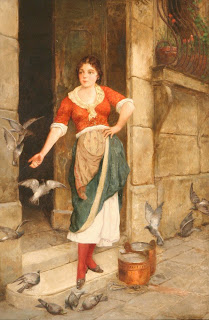INDIAN OIL PAINTING HISTORY :-
------------------------------
------------------------------
The history of oil paint was traced to western Afghanistan sometime between the 5th and 9th Centuries
and it gained popularity during the 15th century. Its practice likely migrated westward during the
middle ages.
Oil paint eventually became the principal medium used for creating art works, as its advantages became widely known.
Renaissance oil painting techniques when used in Indian oil paintings had almost completely replaced tempera paints
in the majority of Europe. Traditional oil painting techniques begin with the artist sketching the figure onto
the canvas with charcoal or a which is thinned paint.
Oil paint is then mixed with turpentine, linseed oil, artist grade mineral spirits or other solvents to create a
thinner and faster drying paint. The artist then constructs the figure in different layers.
There is a basic rule for the application of oil paint which is,fat over lean.
This means that each extra layer of paint should be a bit oilier than the layer below, to allow proper drying.
With getting more and more layers, the oil paint gets oilier (leaner to fatter) or the ultimate painting will
peel or crack.
Use of oil in paintings :-
--------------------------
--------------------------
Painting by using oil is the process of painting with pigments that are mixed with a medium of drying oil
or the linseed oil, available in early modern Europe. Often this linseed oil was boiled with a resin such as
pine resin or even frankincense; these were called varnishes and were valued for their body and gloss.
Other oils occasionally used in Indian oil paintings include walnut oil, and safflower oil. Oils
provide several properties to the paint like less yellowing or varied drying times.
There are some differences seen in the shininess of the paints according to the oil used.
Different oils are often being used by oil painters in a particular painting depending on
certain pigments and the desired effects. Oil paints also develop a specific feel with
regard to the medium.
There are many other painting media that are lately being used in Indian oil paintings,
including cold wax, resins, and varnishes. These media can help a painter to adjust the
translucency of his or her paint, the luster of the paint, the body or density of the paint,
and the capacity of the paint to grasp or conceal the brushstroke. These are closely linked
with the expressive power of oil paint. When looking at original oil paintings, the various
traits of oil paint allow viewer to sense the choices the artist made as they applied the paint.
The paint is still for a viewer and for an artist oil paint is a semi-liquid or a liquid which
should be moved the oil painting.
Usually, the oil paint was transferred to the painting surface using paintbrushes, but there are other methods, including the use of palette knives, rags, etc. Oil paintings stay wet for a longer duration than various other types of materials of the artists, thus helping the artist to alter the texture or form and colour of the figure
if required. Sometimes a painter also removes the whole paint layer and starts afresh. It is done with the help of a rag and a small quantity of turpentine oil for some time when the paint is wet, however after some time, the layer which is hardened should be scraped. Scraping may also be used to make a portrait smooth before glazing and scumbling.
A number of oil paintings display proof of scraping if closely examined, mainly after examining the surface. Oil paint
often dries by oxidation, not evaporation, and is usually dry to the touch in a day to two weeks and is usually dry enough to be varnished in six months to a year. Art experts do not consider an oil painting completely dry until it is sixty to eighty years old.
------------------------------
------------------------------
The history of oil paint was traced to western Afghanistan sometime between the 5th and 9th Centuries
and it gained popularity during the 15th century. Its practice likely migrated westward during the
middle ages.
Oil paint eventually became the principal medium used for creating art works, as its advantages became widely known.
Renaissance oil painting techniques when used in Indian oil paintings had almost completely replaced tempera paints
in the majority of Europe. Traditional oil painting techniques begin with the artist sketching the figure onto
the canvas with charcoal or a which is thinned paint.
Oil paint is then mixed with turpentine, linseed oil, artist grade mineral spirits or other solvents to create a
thinner and faster drying paint. The artist then constructs the figure in different layers.
There is a basic rule for the application of oil paint which is,fat over lean.
This means that each extra layer of paint should be a bit oilier than the layer below, to allow proper drying.
With getting more and more layers, the oil paint gets oilier (leaner to fatter) or the ultimate painting will
peel or crack.
Use of oil in paintings :-
--------------------------
--------------------------
Painting by using oil is the process of painting with pigments that are mixed with a medium of drying oil
or the linseed oil, available in early modern Europe. Often this linseed oil was boiled with a resin such as
pine resin or even frankincense; these were called varnishes and were valued for their body and gloss.
Other oils occasionally used in Indian oil paintings include walnut oil, and safflower oil. Oils
provide several properties to the paint like less yellowing or varied drying times.
There are some differences seen in the shininess of the paints according to the oil used.
Different oils are often being used by oil painters in a particular painting depending on
certain pigments and the desired effects. Oil paints also develop a specific feel with
regard to the medium.
There are many other painting media that are lately being used in Indian oil paintings,
including cold wax, resins, and varnishes. These media can help a painter to adjust the
translucency of his or her paint, the luster of the paint, the body or density of the paint,
and the capacity of the paint to grasp or conceal the brushstroke. These are closely linked
with the expressive power of oil paint. When looking at original oil paintings, the various
traits of oil paint allow viewer to sense the choices the artist made as they applied the paint.
The paint is still for a viewer and for an artist oil paint is a semi-liquid or a liquid which
should be moved the oil painting.
Usually, the oil paint was transferred to the painting surface using paintbrushes, but there are other methods, including the use of palette knives, rags, etc. Oil paintings stay wet for a longer duration than various other types of materials of the artists, thus helping the artist to alter the texture or form and colour of the figure
if required. Sometimes a painter also removes the whole paint layer and starts afresh. It is done with the help of a rag and a small quantity of turpentine oil for some time when the paint is wet, however after some time, the layer which is hardened should be scraped. Scraping may also be used to make a portrait smooth before glazing and scumbling.
A number of oil paintings display proof of scraping if closely examined, mainly after examining the surface. Oil paint
often dries by oxidation, not evaporation, and is usually dry to the touch in a day to two weeks and is usually dry enough to be varnished in six months to a year. Art experts do not consider an oil painting completely dry until it is sixty to eighty years old.













































